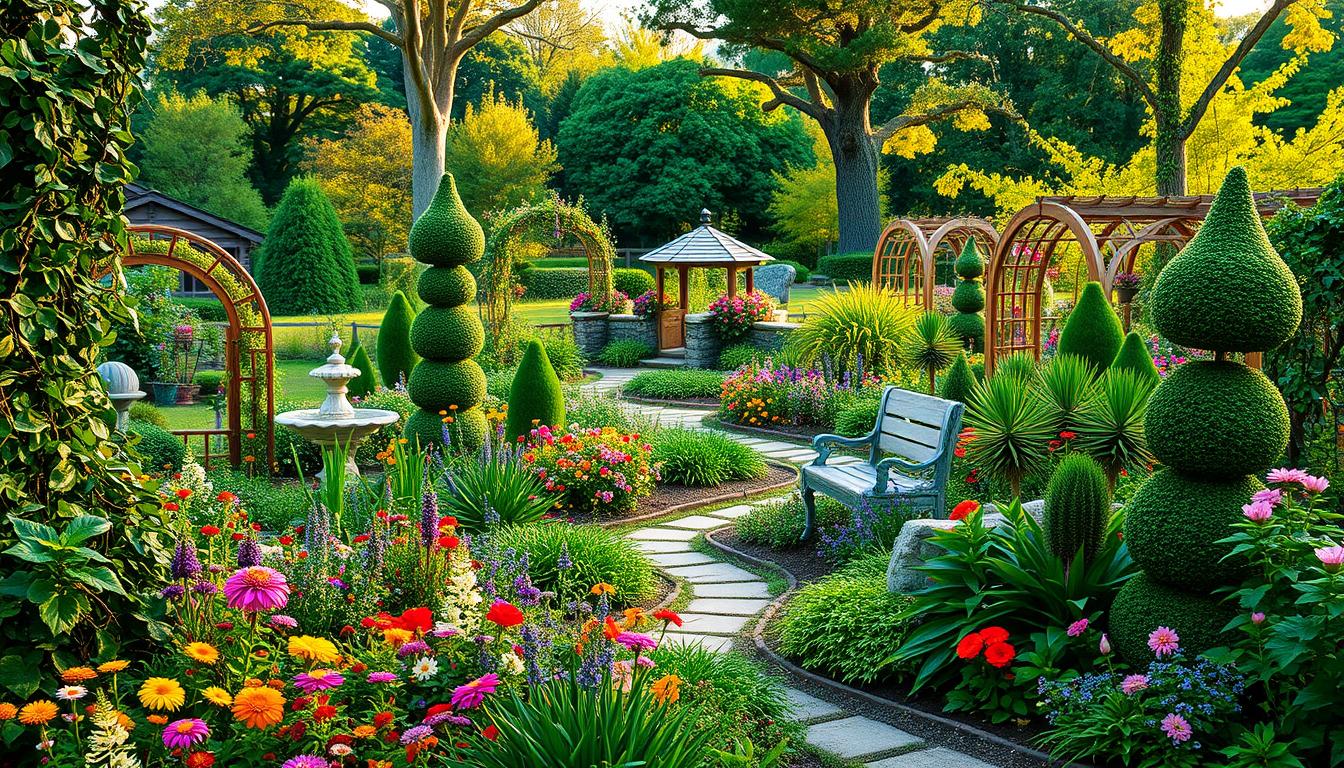Your outdoor space is more than just a yard—it’s a canvas waiting for your personal touch. Whether you have a sprawling lawn or a cozy patio, there are endless ways to transform it into a stunning retreat. From seasonal adaptability to year-round visual appeal, the right approach can make your area both functional and beautiful.
Looking ahead to 2025, trends like edible landscapes and vibrant flower beds are gaining popularity. These ideas not only enhance aesthetics but also add practicality to your space. No matter where you live, from the sunny coasts to the cooler northern regions, there’s inspiration to suit every climate and lifestyle.
We’ve curated 17 unique concepts to help you get started. Whether you’re a seasoned gardener or a beginner, these tips will spark your creativity. Plus, we’d love to hear about your own projects—share your designs and join the community of passionate homeowners!
Key Takeaways
- Personalize your outdoor space with creative designs.
- Explore ideas for all yard sizes and climates.
- Focus on seasonal adaptability for year-round beauty.
- Stay updated with trending 2025 garden trends.
- Combine functionality and aesthetics for a balanced look.
- Get inspired by regional examples from coast to coast.
- Share your own designs and join the community.
Introduction to Gardens Designs Ideas
Small spaces can shine with the right balance of plants and hardscaping. A 50/50 ratio of planting to landscaping ensures your area feels lush yet functional. This approach works wonders for patios, balconies, or compact yards.
For those with limited room, vertical gardening is a game-changer. It maximizes your space by growing plants upward on walls or trellises. This not only saves ground area but also adds a unique visual element to your design.
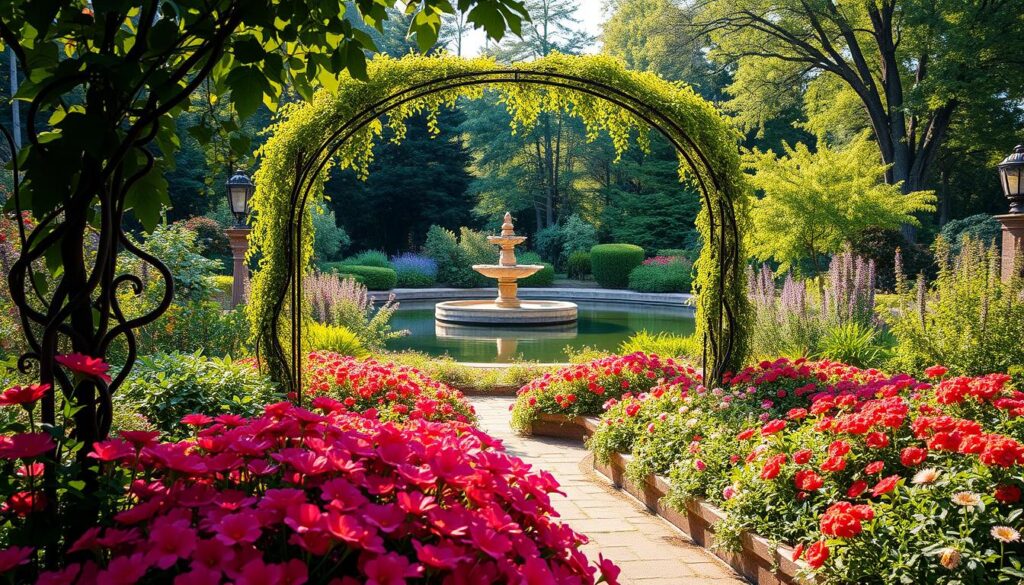
When planning your outdoor area, remember the three golden rules: movement, immersive planting, and destination points. These principles guide the flow and feel of your garden, making it both inviting and dynamic.
Budget-friendly alternatives like gravel instead of paving can save money while adding texture. Sensory elements, such as fragrant herbs or rustling grasses, engage all five senses for a truly immersive experience.
Color theory also plays a role. Cool tones like blues and purples create a calming effect, while warm hues like reds and yellows energize the space. For more tips on getting started, check out this guide on how to start a garden.
1. Create a Woodland Path Garden
Transform your outdoor area into a serene woodland retreat with a natural path. This concept brings the calming essence of a forest to your home, blending trees, shrubs, and plants for a harmonious look.
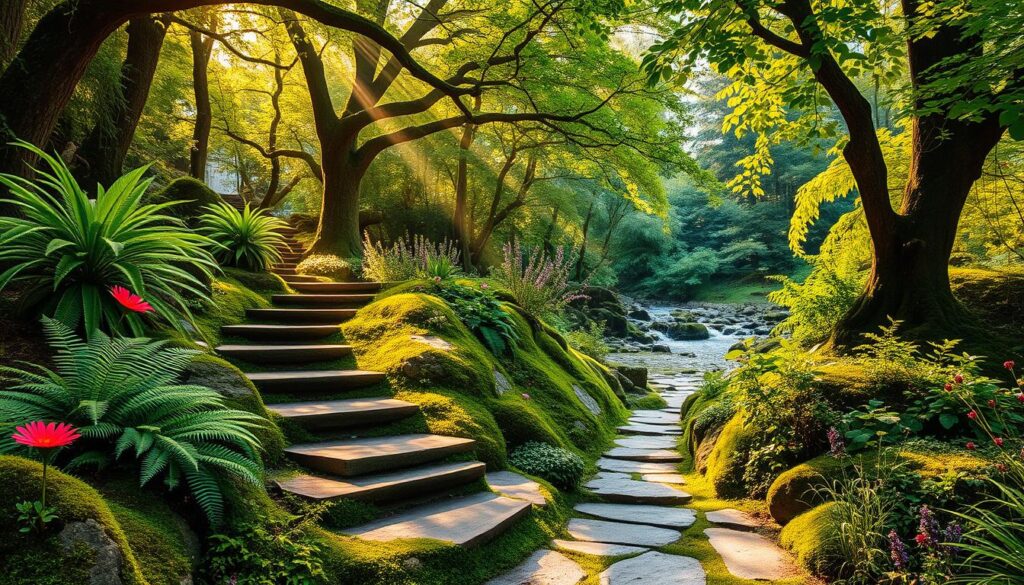
Start by using native ferns like Matteuccia struthiopteris for lush undergrowth. Pair them with spring ephemerals such as Virginia bluebells and trilliums for seasonal bursts of color. These combinations create a dynamic and ever-changing landscape.
Design winding paths using cedar mulch or moss-covered stones. This adds texture and guides visitors through the space. For a cozy touch, include seating nooks with weather-resistant cedar benches. These spots invite you to pause and enjoy the surroundings.
“A woodland path is more than a walkway—it’s an experience that connects you with nature.”
Don’t forget vertical space! Climbing hydrangeas can add height and visual interest. They grow effortlessly on walls or trellises, making them perfect for smaller areas.
Plant Recommendations for a Woodland Path
| Plant | Role | Seasonal Interest |
|---|---|---|
| Matteuccia struthiopteris | Undergrowth | Spring to Fall |
| Virginia Bluebells | Spring Ephemeral | Spring |
| Climbing Hydrangea | Vertical Element | Summer |
With these tips, you can make garden spaces that feel like a natural escape. A woodland path is not just a design—it’s a way to bring the beauty of the forest to your ground.
2. Design a Bark-Appeal Garden
Add year-round charm to your outdoor area with a bark-focused design. This approach highlights natural textures, creating visual interest even in the colder months. By carefully selecting plants with unique bark, you can transform your space into a stunning retreat.
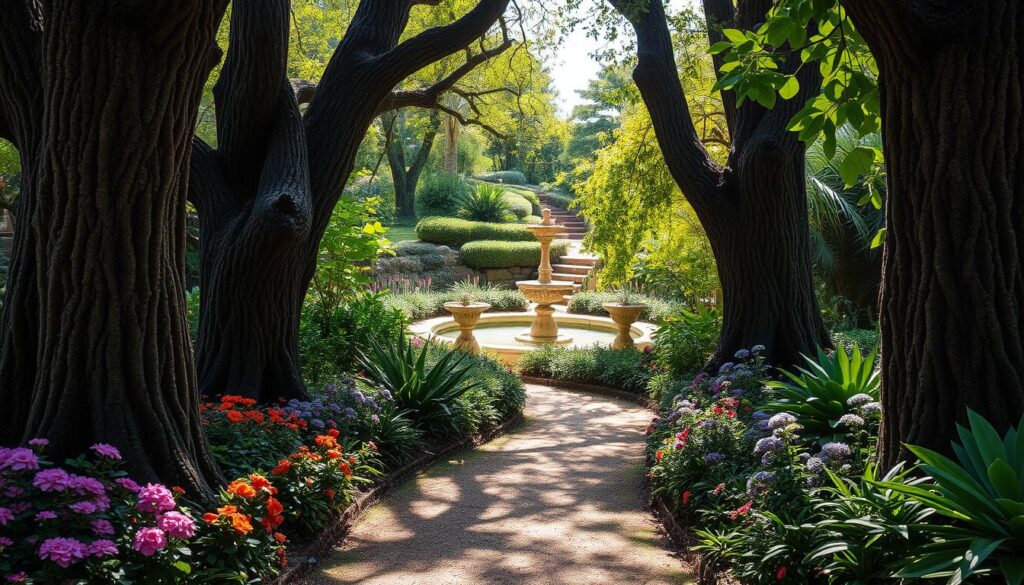
Start with the paperbark maple (Acer griseum), known for its peeling cinnamon-colored bark. This tree adds warmth and texture, especially in winter. Pair it with redtwig dogwood, whose vibrant red stems pop against snowy backdrops. Birch species, with their striking white bark, also make excellent companions.
Evergreen conifers provide a lush backdrop, ensuring your garden stays vibrant year-round. Ornamental grasses add movement and contrast, swaying gently in the breeze. For a pop of color, include winterberry holly. Its bright red berries stand out against the winter landscape.
“A bark-focused garden is a celebration of nature’s textures, offering beauty in every season.”
With these elements, you can create a space that’s both visually appealing and functional. Whether you’re looking to enhance your design or add seasonal interest, a bark-appeal garden is a timeless choice.
3. Build a Deer-Resistant Garden
Protecting your outdoor space from wildlife doesn’t mean sacrificing beauty. With the right plants, you can create a stunning retreat that keeps deer at bay. Start by choosing varieties that naturally deter these visitors while enhancing your yard’s appeal.
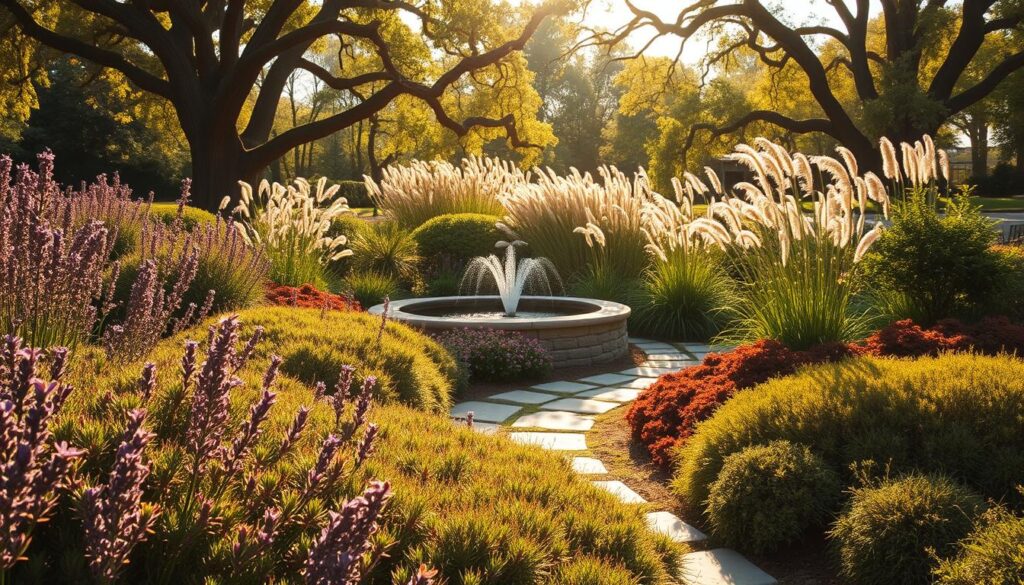
Russian sage and lavender are excellent choices for borders. Their strong scents act as natural repellents, keeping deer away while adding color and texture. Pair them with thorny barberry hedges for an extra layer of protection. These hedges not only serve as a fence but also add visual interest to your space.
For a softer touch, incorporate fuzzy-leaved lamb’s ear (Stachys byzantina). Its unique texture is unappealing to deer, making it a practical yet beautiful addition. Allium bulbs are another great option. Their pungent odor deters wildlife while their vibrant blooms add a pop of color.
“A deer-resistant garden is a blend of beauty and practicality, ensuring your space thrives without unwanted visitors.”
For those looking to add fruit trees, consider compact varieties that are less attractive to deer. These trees provide both functionality and aesthetics, making them a smart choice for any outdoor area. With these strategies, you can create a space that’s both stunning and wildlife-proof.
Wildlife-Proof Planting Strategies
- Use Russian sage and lavender for natural repellents.
- Add thorny barberry hedges as protective barriers.
- Incorporate lamb’s ear for its fuzzy, deer-resistant leaves.
- Plant allium bulbs for their unappetizing scent.
- Consider compact fruit trees for added functionality.
4. Cultivate a Pollinator Garden
Invite nature’s helpers into your space with a pollinator-friendly setup. These gardens not only add beauty but also play a vital role in supporting local ecosystems. By choosing the right flowers and plants, you can create a haven for bees, butterflies, and other essential pollinators.
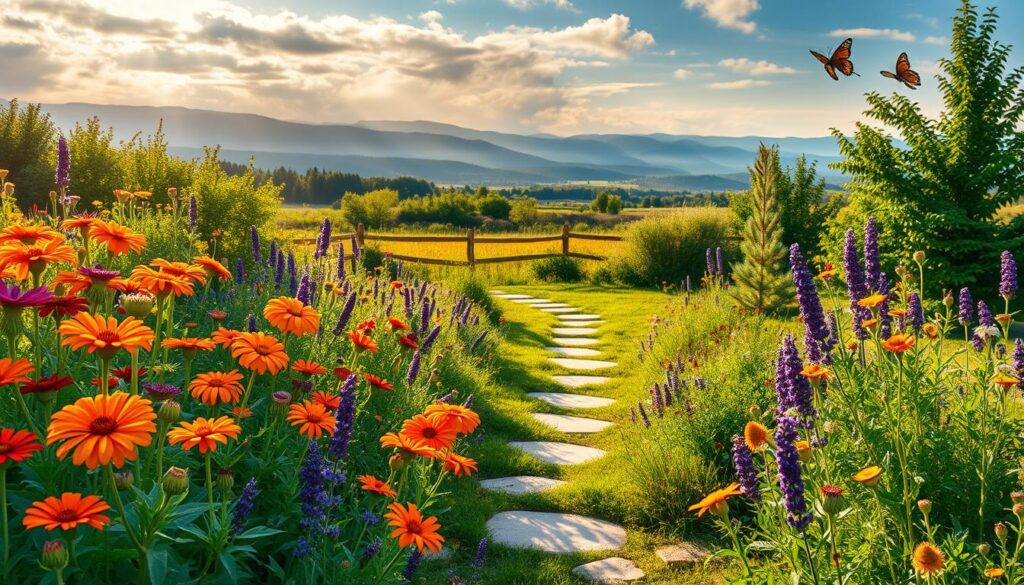
Start by clustering native milkweed varieties. These are essential for monarch butterflies, providing both food and habitat. Pair them with tubular flowers like penstemon, which attract hummingbirds with their vibrant blooms. For nighttime visitors, include night-blooming moonflowers. These fragrant blossoms are perfect for moths and add a magical touch to your design.
Plan for a continuous bloom schedule. Early spring crocus can kick off the season, while late-blooming asters ensure pollinators have food into the fall. This approach keeps your space lively and supportive throughout the year.
“A pollinator garden is more than a pretty space—it’s a lifeline for local wildlife.”
Don’t forget to add shallow water stations with landing stones. These provide hydration for pollinators and create a welcoming environment. With these tips, you can craft a space that’s both stunning and ecologically beneficial.
5. Plan the Ultimate Kitchen Garden
Turn your backyard into a functional and beautiful kitchen retreat. A well-planned kitchen garden combines fresh herbs and vegetables with stunning aesthetics. Whether you have a spacious yard or a cozy patio, this approach works for any space.

Start with Jon Carloftis’ layout, which emphasizes balance and practicality. Use raised beds to organize your plants efficiently. This method not only saves space but also makes maintenance easier. Pair edible plants with ornamental ones for a visually appealing mix.
Edible Aesthetics Approach
Interplant nasturtiums with kale to naturally deter pests. These vibrant flowers add color while protecting your crops. Scarlet runner beans serve as edible privacy screens, perfect for creating a cozy nook. Their bright blooms attract pollinators, enhancing your garden’s ecosystem.
Incorporate artichokes as architectural elements. Their bold foliage adds height and texture to your design. Marigold borders protect against nematodes while adding a sunny touch. For continuous harvest, practice succession planting. This ensures fresh produce throughout the growing season.
“A kitchen garden is more than a source of food—it’s a celebration of nature’s beauty and bounty.”
With these tips, you can create a space that’s both practical and visually stunning. A kitchen garden is the perfect way to enjoy fresh produce while enhancing your outdoor area.
6. Embrace a Wildflower Garden
Bring the untamed beauty of nature to your outdoor space with a wildflower retreat. These gardens are not only stunning but also eco-friendly, supporting local wildlife and requiring minimal upkeep. Whether you have a large lawn or a small patch of ground, wildflowers can transform it into a vibrant, natural landscape.

Start by choosing regional seed mixes, like those from American Meadows. These blends are tailored to your area, ensuring your plants thrive. For a structured look, create mowed pathways through the meadow areas. This adds accessibility while maintaining the wild, natural feel.
Controlled Meadow Aesthetics
Incorporate butterfly weed (Asclepias tuberosa) to attract pollinators and add a pop of orange to your garden. Timing is key—plant in autumn for natural stratification, which helps seeds germinate in spring. For those looking to reduce lawn maintenance, consider gravel alternatives. This adds texture and reduces the need for mowing.
“A wildflower garden is a celebration of nature’s spontaneity, offering beauty and ecological benefits in one.”
With these tips, you can create a space that’s both visually stunning and environmentally responsible. A wildflower garden is the perfect way to embrace nature’s charm while enhancing your outdoor area.
7. Grow a Perennial Cutting Garden
Bring fresh blooms into your home year-round with a perennial cutting setup. This approach not only beautifies your space but also provides a sustainable source for bouquets. By carefully selecting plants that bloom at different times, you can enjoy a continuous supply of flowers throughout the season.
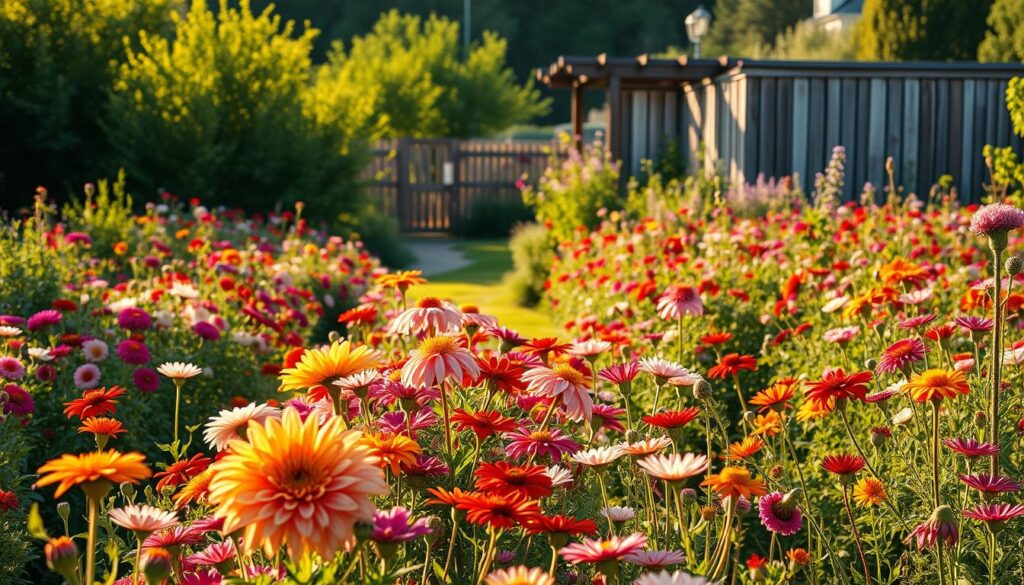
Start with staggered bloomers like peonies, dahlias, and chrysanthemums. These varieties ensure that your garden is always vibrant. Peonies kick off the spring, followed by dahlias in summer, and chrysanthemums in fall. This sequence keeps your space lively and your vases full.
Sustainable Bouquet Source
Incorporate fragrant stock flowers (Matthiola incana) for a sensory delight. Their sweet scent enhances any bouquet, making them a must-have. For better air circulation and plant health, use a zigzag planting pattern. This method reduces disease risk and promotes growth.
Add specialty varieties like ‘Black Baccara’ roses for a dramatic touch. Their deep, velvety petals create stunning arrangements. Pair them with foliage-heavy plants for a balanced design. This approach ensures your bouquets are both beautiful and long-lasting.
“A cutting garden is more than a source of flowers—it’s a way to bring nature’s beauty indoors.”
With these tips, you can create a space that’s both functional and visually appealing. A perennial cutting garden is the perfect way to enjoy fresh blooms while enhancing your outdoor area.
8. Design a Glorious Kitchen Garden
Transform your backyard into a functional and stylish kitchen retreat with a French-inspired potager. This approach combines fresh herbs and vegetables with elegant design, creating a space that’s both productive and beautiful.
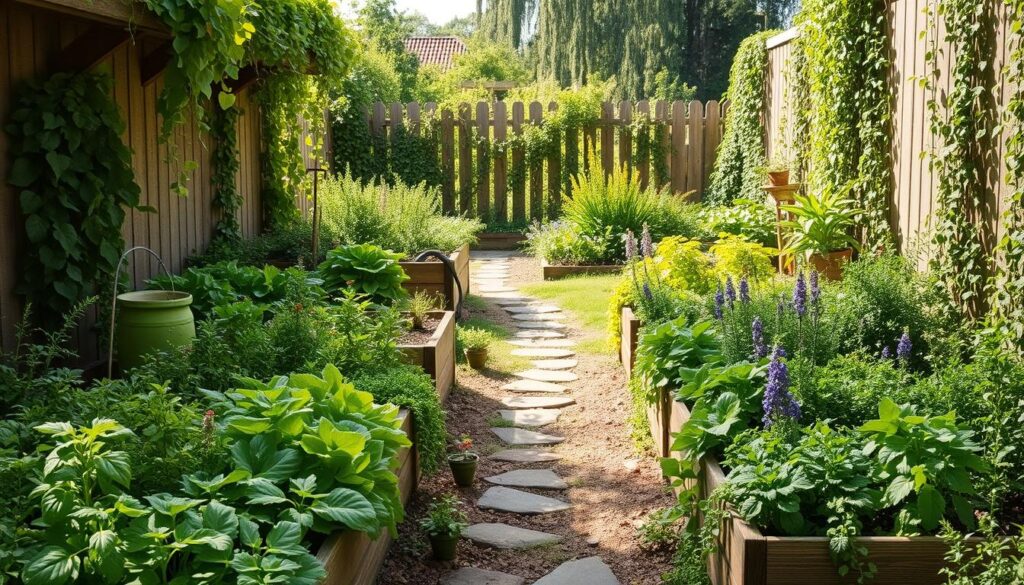
Start by creating geometric patterns with dwarf boxwood. These low hedges add structure and charm to your garden. For efficient use of space, interplant radishes with slower-growing carrots. This method maximizes your yield while keeping the area tidy.
French Potager Inspiration
Vertical trellises are perfect for cucumbers and melons. They save ground space and add height to your design. Incorporate edible flowers like borage and calendula for a pop of color and added functionality. These blooms attract pollinators and can be used in salads or garnishes.
Add copper plant markers for a touch of functional decor. They not only label your plants but also add a rustic charm to your raised bed setup. This combination of practicality and aesthetics makes your kitchen garden a true retreat.
“A kitchen garden is more than a source of food—it’s a celebration of nature’s beauty and bounty.”
With these tips, you can create a space that’s both visually stunning and highly productive. A French-inspired potager is the perfect way to enjoy fresh produce while enhancing your outdoor area.
9. Start an Herb Garden
Herbs bring both flavor and wellness to your outdoor space. Whether you have a sprawling yard or a cozy patio, these versatile plants are perfect for any setup. From culinary uses to medicinal benefits, an herb garden is a practical and rewarding addition to your home.
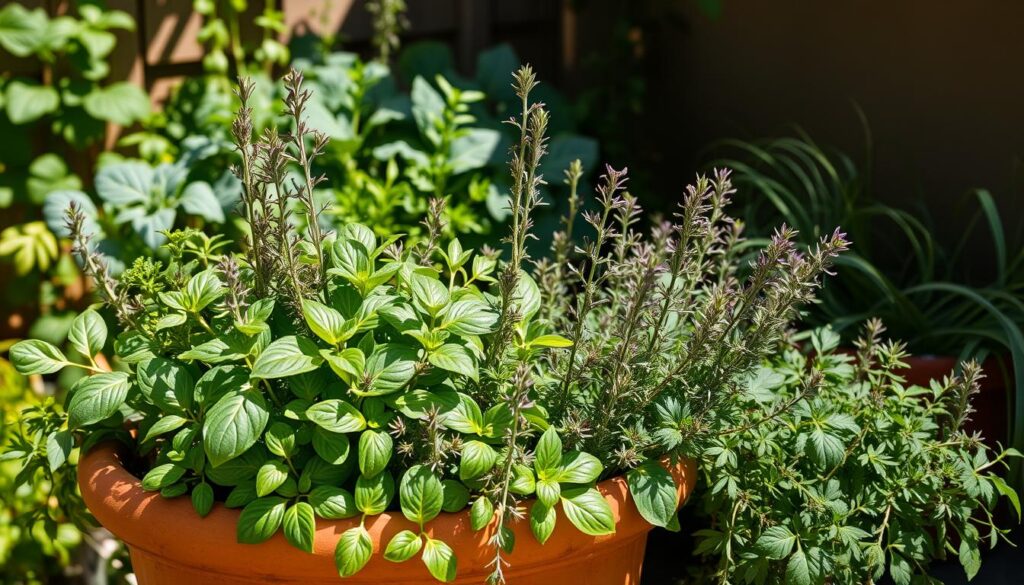
Culinary & Medicinal Planting
Organize your herbs into themed sections for easy access and visual appeal. Create an Italian corner with basil, oregano, and thyme. For medicinal purposes, plant chamomile, lavender, and echinacea. A tea section with mint, lemon balm, and stevia adds both flavor and functionality.
Small spaces? No problem. Use stackable containers to maximize your area. These are ideal for balconies or compact patio setups. They keep your plants organized and accessible while saving ground space.
Protect tender perennials like rosemary during winter. Bring them indoors or use frost covers to ensure they thrive year-round. For invasive herbs like mint, plant them in submerged containers to prevent them from overtaking your garden.
“An herb garden is more than a source of fresh ingredients—it’s a sensory experience that engages sight, smell, and taste.”
Herb Garden Essentials
| Herb | Type | Best Use |
|---|---|---|
| Basil | Culinary | Italian dishes |
| Lavender | Medicinal | Relaxation, aromatherapy |
| Mint | Tea | Beverages, desserts |
With these tips, you can create a functional and beautiful herb garden. Whether you’re a seasoned gardener or a beginner, this project is a simple way to enhance your space and lifestyle.
10. Create a Cottage Garden
Capture the charm of a countryside retreat with a cottage-inspired outdoor space. This romantic, informal style blends flowers, shrubs, and whimsical elements to create a cozy, inviting atmosphere. Whether you have a sprawling yard or a compact area, a cottage garden adds timeless beauty to your home.
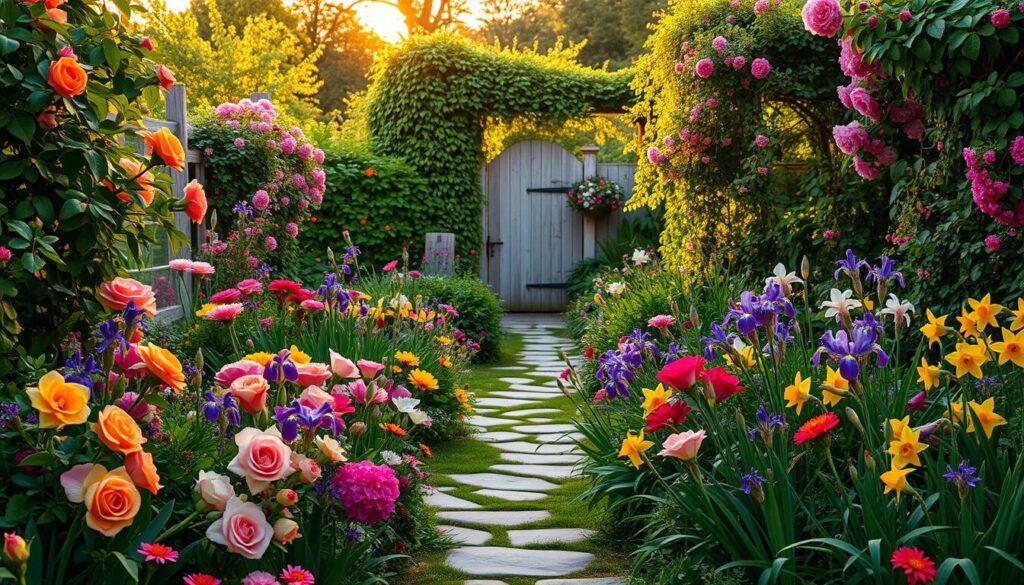
Romantic Informal Style
Start by combining old-fashioned roses with clematis vines. This pairing creates a lush, vertical display that adds height and texture to your design. Use picket fences not only as boundaries but also as supports for climbing peas or beans. This dual-purpose approach maximizes space while enhancing the rustic charm.
Add whimsical touches like birdcage planters or vintage garden tools. These elements bring personality and a sense of nostalgia to your space. For a natural, self-sustaining look, plant self-seeding biennials such as foxgloves and hollyhocks. These flowers return year after year, filling your garden with color and life.
“A cottage garden is a celebration of nature’s spontaneity, offering beauty and charm in every corner.”
To maintain cohesion, stick to a limited color palette. Soft pinks, purples, and whites create a harmonious look, while pops of yellow or blue add contrast. This approach ensures your garden feels balanced and intentional.
Essential Plants for a Cottage Garden
| Plant | Role | Seasonal Interest |
|---|---|---|
| Old-Fashioned Roses | Vertical Display | Spring to Fall |
| Clematis Vines | Climbing Accent | Summer |
| Foxgloves | Self-Seeding Biennial | Spring |
With these tips, you can create a cottage garden that’s both enchanting and low-maintenance. This timeless design brings the warmth of the countryside to your outdoor space, making it a true retreat.
11. Plan a Porch Border Garden
Your front yard can become a welcoming masterpiece with a thoughtfully planned porch border. This design not only enhances your home’s curb appeal but also creates a warm and inviting atmosphere for visitors. Whether you have a spacious entryway or a cozy patio, a porch border garden is a versatile solution.
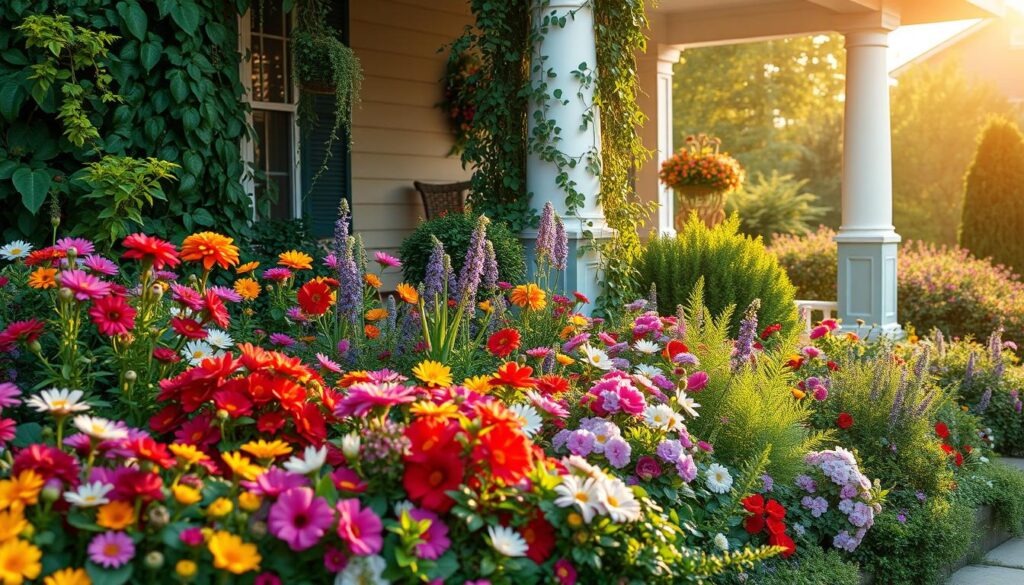
Welcoming Entryway Design
Start by using graduated heights to create visual interest. Low-growing plants like creeping thyme work beautifully at the edges, while taller dwarf conifers add structure and depth. This layering technique ensures your garden looks balanced and dynamic.
Incorporate fragrant plants near seating areas to engage the senses. Lavender and rosemary are excellent choices, offering both aroma and practicality. These plants thrive in sunny spots and add a touch of elegance to your design.
Seasonal containers are another great way to keep your porch border vibrant year-round. Start with pansies in spring, transition to geraniums in summer, and finish with mums in fall. This rotation ensures your space always has a pop of color.
“A porch border garden is more than decoration—it’s a reflection of your home’s personality and style.”
For a formal touch, use symmetrical urns or planters. These add a classic, polished look to your entryway. Pair them with evergreen shrubs for a timeless appeal that requires minimal maintenance.
By combining these elements, you can create a porch border garden that’s both beautiful and functional. It’s the perfect way to make your front yard a true reflection of your home’s charm.
12. Cultivate a Fragrant Garden
Engage your senses with a fragrant outdoor retreat that delights the nose and the eyes. Aromatic plants and flowers can transform your space into a sensory haven, offering beauty and tranquility in every season. Whether you have a sprawling yard or a cozy corner, a fragrant garden is a rewarding addition to your home.
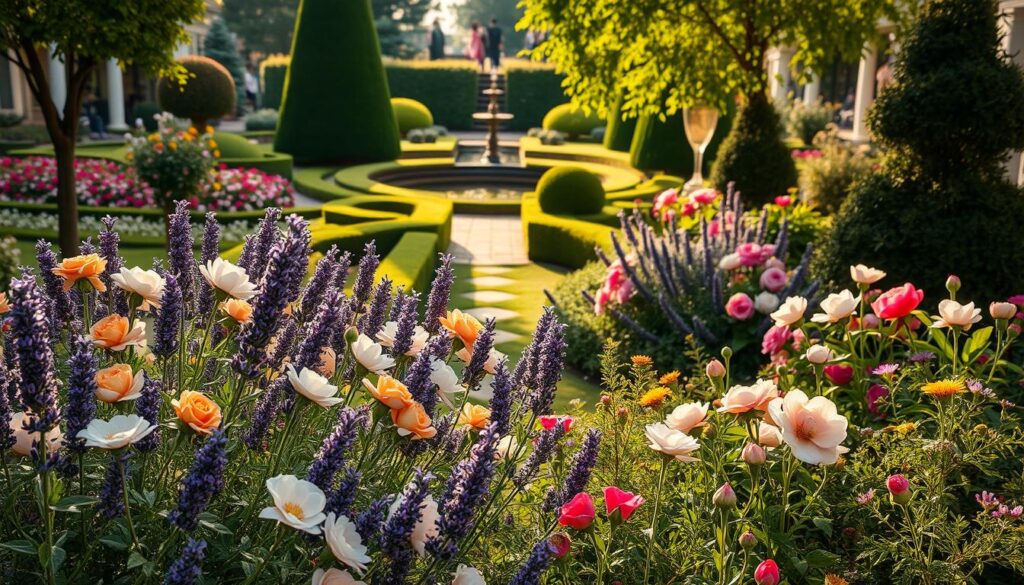
Aromatic Landscape Design
Start by planting night-blooming jasmine near windows or seating areas. Its intoxicating scent fills the evening air, creating a magical atmosphere. For pathways, consider a lavender labyrinth. This not only adds fragrance but also serves as a stunning visual feature. Sweet autumn clematis on arbors provides a burst of aroma and color in late summer.
Incorporate citrus trees in movable planters for flexibility and a fresh, zesty fragrance. These trees thrive in sunny spots and can be moved indoors during colder months. Pair them with fragrant shrubs like gardenias or lilacs for a layered sensory experience.
“A fragrant garden is more than a visual delight—it’s a journey for the senses, offering peace and joy in every breath.”
Essential Plants for a Fragrant Garden
| Plant | Fragrance | Best Location |
|---|---|---|
| Night-Blooming Jasmine | Sweet, Intense | Near Windows |
| Lavender | Calming, Herbal | Pathways |
| Sweet Autumn Clematis | Vanilla-Like | Arbors |
With these tips, you can create a fragrant garden that engages all your senses. It’s the perfect way to enhance your outdoor space and enjoy nature’s aromatic gifts.
13. Design a Perennial Garden
A perennial garden offers year-round beauty with minimal effort. These plants return each season, making them a sustainable and cost-effective choice for your outdoor space. Whether you’re a beginner or an experienced gardener, perennials provide lasting color and texture.

Low-Maintenance Color Strategy
Start with the “thriller, filler, spiller” formula for container planting. This approach ensures a balanced and visually appealing design. Use tall, dramatic flowers as the thriller, medium-sized plants as fillers, and trailing varieties as spillers.
Incorporate drought-tolerant sedum varieties for resilience. These hardy plants thrive in dry conditions and add texture to your garden. Their succulent leaves and vibrant blooms make them a standout choice.
Add ornamental grasses for winter interest. These grasses provide structure and movement, even in colder months. Their feathery plumes and golden hues create a stunning contrast against snow.
“A well-planned perennial garden is a gift that keeps on giving, offering beauty and simplicity year after year.”
- Use the “thriller, filler, spiller” formula for balanced containers.
- Plant drought-tolerant sedum for low-maintenance resilience.
- Incorporate ornamental grasses for winter texture and interest.
- Focus on foliage diversity to add depth and contrast.
- Remember the three-year growth rule for healthy perennials.
By following these tips, you can create a perennial garden that’s both beautiful and easy to maintain. It’s the perfect way to enjoy a vibrant outdoor space throughout the year.
14. Build a Water Garden
Bring the soothing sounds of nature to your home with a water feature. A water garden adds both tranquility and visual appeal to your outdoor space. Whether you have a spacious yard or a cozy patio, this aquatic ecosystem can transform your area into a serene retreat.
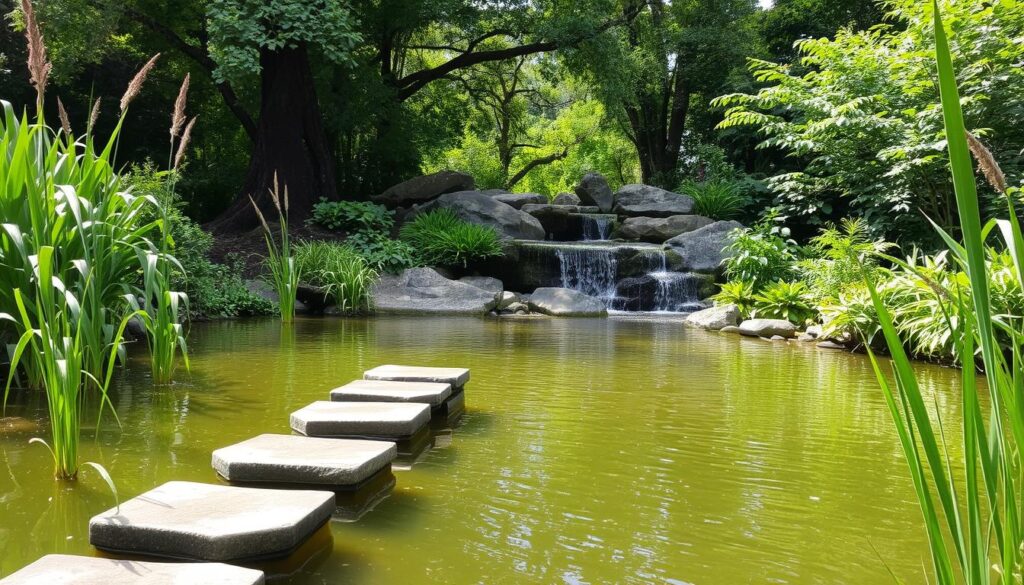
Aquatic Ecosystem Creation
Start by using dwarf papyrus in container water gardens. This plant adds height and texture, creating a natural look. Pair it with floating plants like water hyacinth for a balanced and vibrant display. These plants not only enhance the aesthetics but also help maintain water quality.
Add mosquito fish to your water feature for natural pest control. These small fish are effective at keeping mosquito populations in check. They also add life and movement to your garden, making it more dynamic.
Create soothing spillway sounds with tiered containers. This design mimics the gentle flow of a stream, adding an auditory element to your space. The sound of water can be incredibly calming, making your garden a perfect spot to relax.
“A water garden is more than a decorative feature—it’s a living ecosystem that brings peace and beauty to your home.”
Incorporate multi-functional seating or storage around your water feature. This adds practicality to your design, making the space both beautiful and useful. Whether it’s a bench with hidden storage or a small table, these elements enhance the overall experience.
- Use dwarf papyrus for height and texture.
- Add mosquito fish for natural pest control.
- Incorporate floating plants like water hyacinth.
- Create spillway sounds with tiered containers.
- Include multi-functional seating or storage.
With these tips, you can create a water garden that’s both stunning and functional. It’s the perfect way to bring the calming presence of water into your outdoor space.
15. Create a Raised Bed Garden
Elevate your growing experience with a raised bed setup that combines practicality and style. These structures are perfect for cultivating vegetables, herbs, and flowers while keeping your space organized and accessible. Whether you have limited ground or want to improve soil quality, raised beds are a versatile solution.
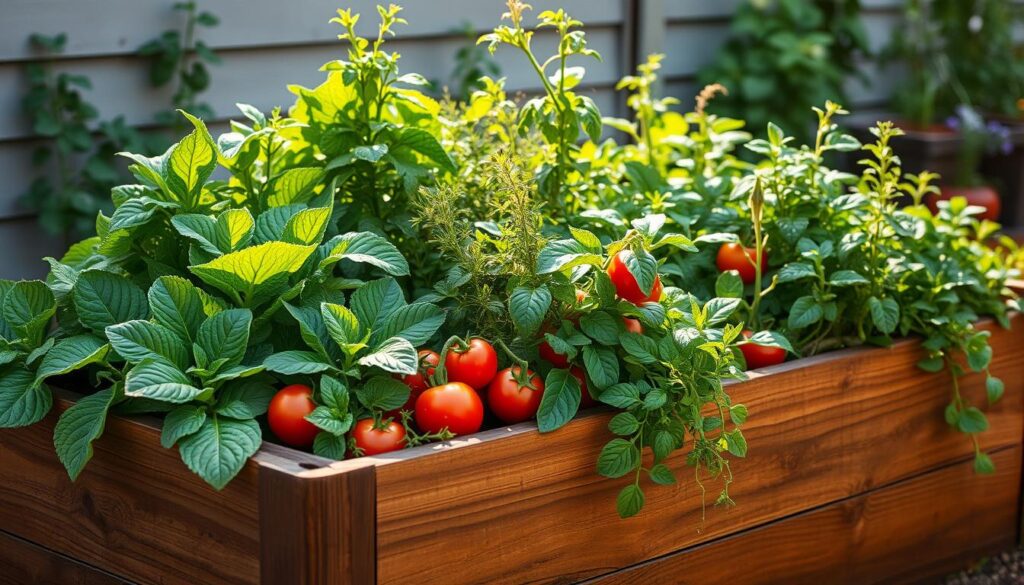
Ergonomic Growing Solutions
When choosing materials, cedar is a popular option for its durability and natural resistance to rot. Composite materials are also a great choice for long-lasting design. Both options ensure your raised bed stands the test of time.
For year-round growing, consider adding cold frames with hinged lids. These protect your plants from frost and extend the growing season. Square foot planting grids are another smart addition. They help maximize space and make it easier to manage your crops.
“A well-planned raised bed garden is a game-changer for both beginners and experienced growers.”
Vertical growing techniques, like trellises or stacked planters, are ideal for small spaces. They allow you to grow more in less area. For accessibility, ensure your beds are at a comfortable height, especially for wheelchair users. This makes gardening enjoyable for everyone.
- Use cedar or composite materials for durability.
- Add cold frames for year-round growing.
- Implement square foot planting grids for efficiency.
- Explore vertical growing options for small spaces.
- Consider wheelchair-accessible heights for inclusivity.
With these tips, you can create a raised bed garden that’s both functional and beautiful. It’s the perfect way to grow fresh produce and enhance your outdoor space.
16. Plan a Patio Garden Bed
Turn your patio into a vibrant outdoor retreat with a thoughtfully planned garden bed. This setup blends functionality and style, creating a seamless extension of your living space. Whether you have a small balcony or a spacious deck, a patio garden bed can transform your area into a lush, inviting oasis.
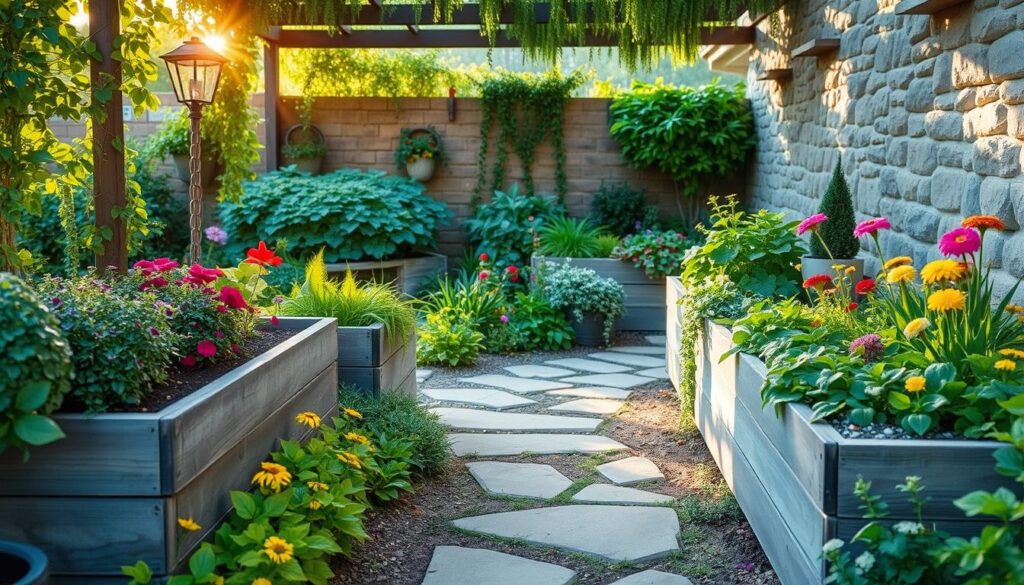
Outdoor Room Integration
Use built-in planters as natural privacy screens. These not only add greenery but also create a cozy, secluded atmosphere. Pair them with dwarf fruit trees in decorative pots for a touch of elegance and practicality. These trees thrive in containers and provide fresh produce right on your patio.
Add weather-resistant outdoor rugs to define the space and add warmth. These rugs are durable and easy to clean, making them perfect for outdoor use. For a cohesive look, choose colors and patterns that complement your plants and furniture.
“A patio garden bed is more than a design—it’s a way to bring nature into your daily life, creating a peaceful retreat just steps from your door.”
Incorporate solar lighting for ambiance and functionality. String lights or pathway markers can illuminate your space while adding a magical touch. These eco-friendly options are easy to install and maintain, making them a smart choice for any patio.
Essential Elements for a Patio Garden Bed
| Element | Purpose | Example |
|---|---|---|
| Built-in Planters | Privacy & Greenery | Boxwood Hedges |
| Dwarf Fruit Trees | Decorative & Functional | Lemon or Fig Trees |
| Solar Lighting | Ambiance & Safety | String Lights |
With these tips, you can create a patio garden bed that’s both beautiful and practical. It’s the perfect way to enjoy nature while enhancing your outdoor living space.
Conclusion: Transform Your Outdoor Space with These Gardens Designs Ideas
Revitalize your outdoor area with a blend of beauty and practicality. Whether you’re working with a small patio or a spacious yard, these creative approaches ensure your space is both functional and visually stunning. Start small and implement changes in phases to make the process manageable and enjoyable.
Remember the three golden rules of design: movement, immersive planting, and destination points. These principles will guide you in creating a cohesive and inviting garden. For inspiration, consider joining the garden submission program to share your progress and learn from others.
Ready to take the next step? Explore our Landscape Design hub for more tips and ideas. Transform your outdoor space into a retreat that reflects your style and enhances your lifestyle.

